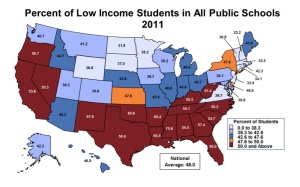Consider three maps—one using data from the 1860 Census, one focusing on public schools in 2011, and one detailing the remaining states allowing corporal punishment in schools:
[1860; click to enlarge]
[2011; click to enlarge]
[2005-2006; click to enlarge]
“A majority of students in public schools throughout the American South and West are low-income for the first time in at least four decades, according to a new study that details a demographic shift with broad implications for the country,” explains Lyndsey Layton, based on the report from the Southern Education Foundation (SEF).
The data in the SEF report parallel in many ways the documenting of in-school segregation lingering in the South as portrayed in the HBO film Little Rock Central: Fifty Years Later and reported by Felicia Lee:
On a recent visit to Central High, Ms. Trickey spoke to a self-segregated classroom: whites on one side, blacks on the other. An…
View original post 1,064 more words




 I wonder what the educational system would look like in our country if everyone sent their child to a public school. I wonder if there were no choices outside of public education if the state of education in the United States would be in a very different place.
I wonder what the educational system would look like in our country if everyone sent their child to a public school. I wonder if there were no choices outside of public education if the state of education in the United States would be in a very different place.